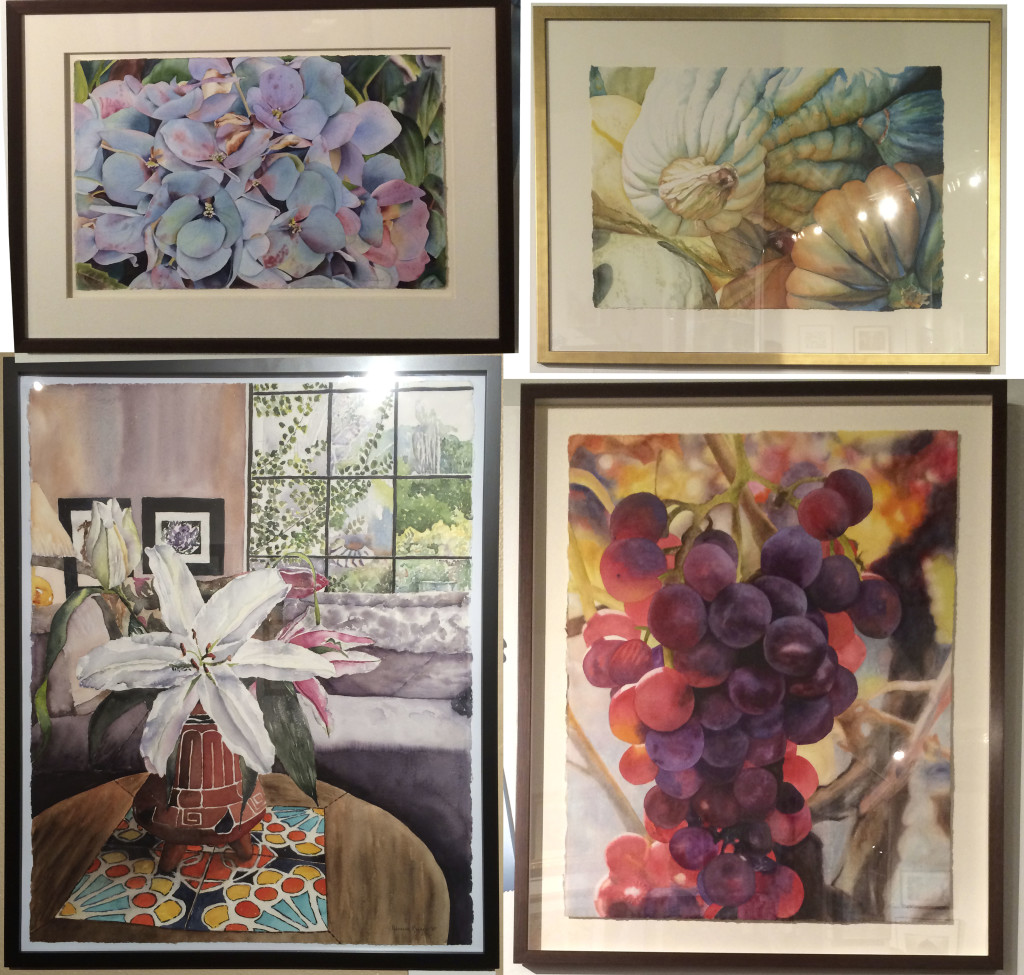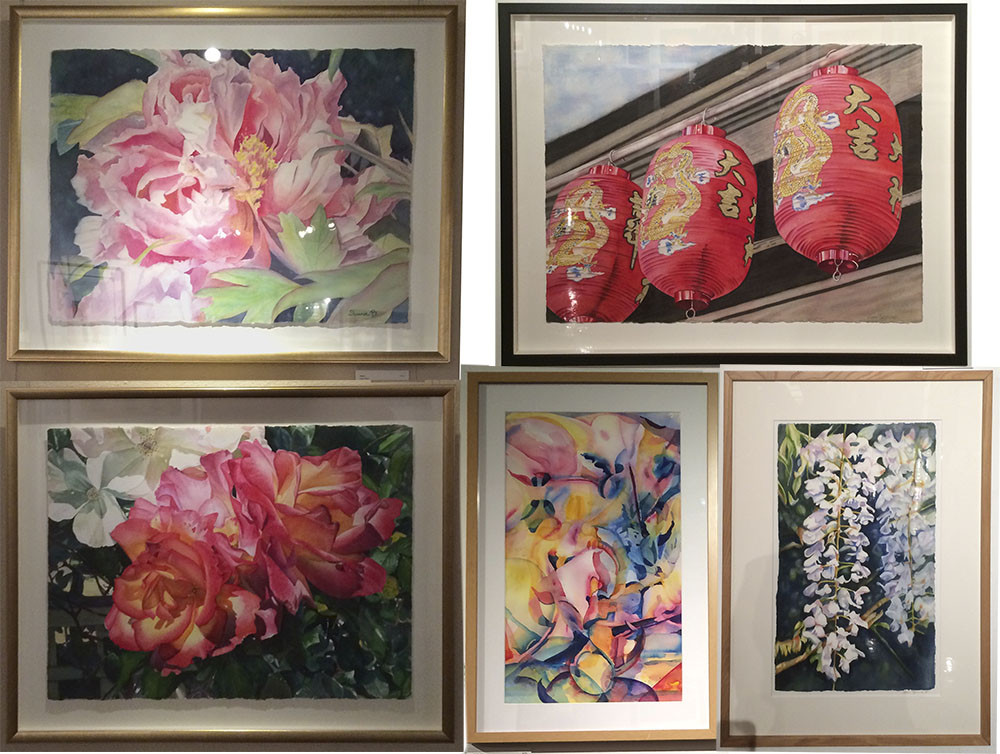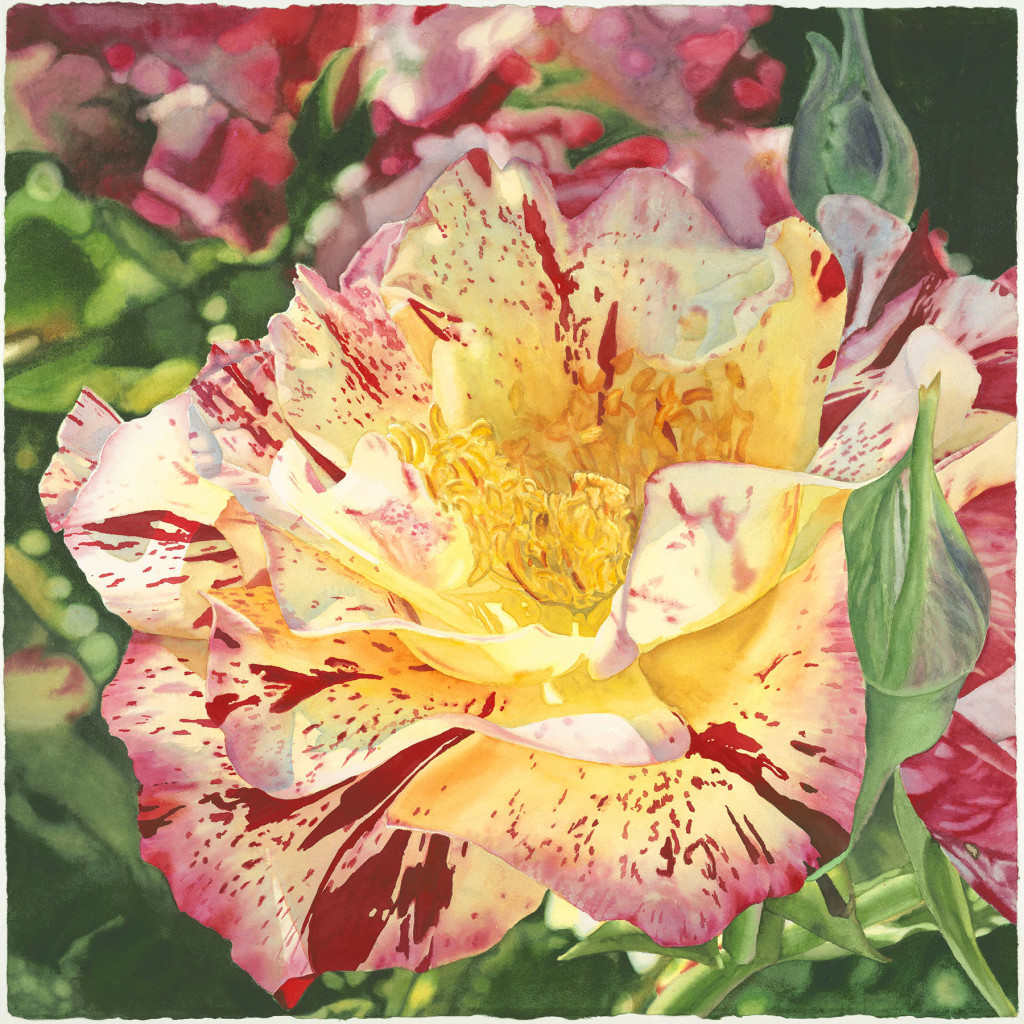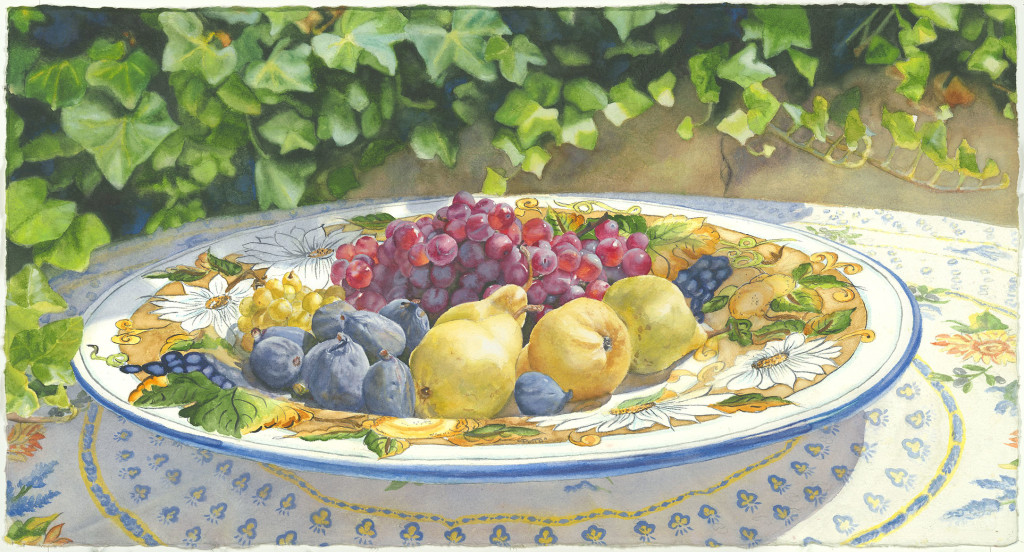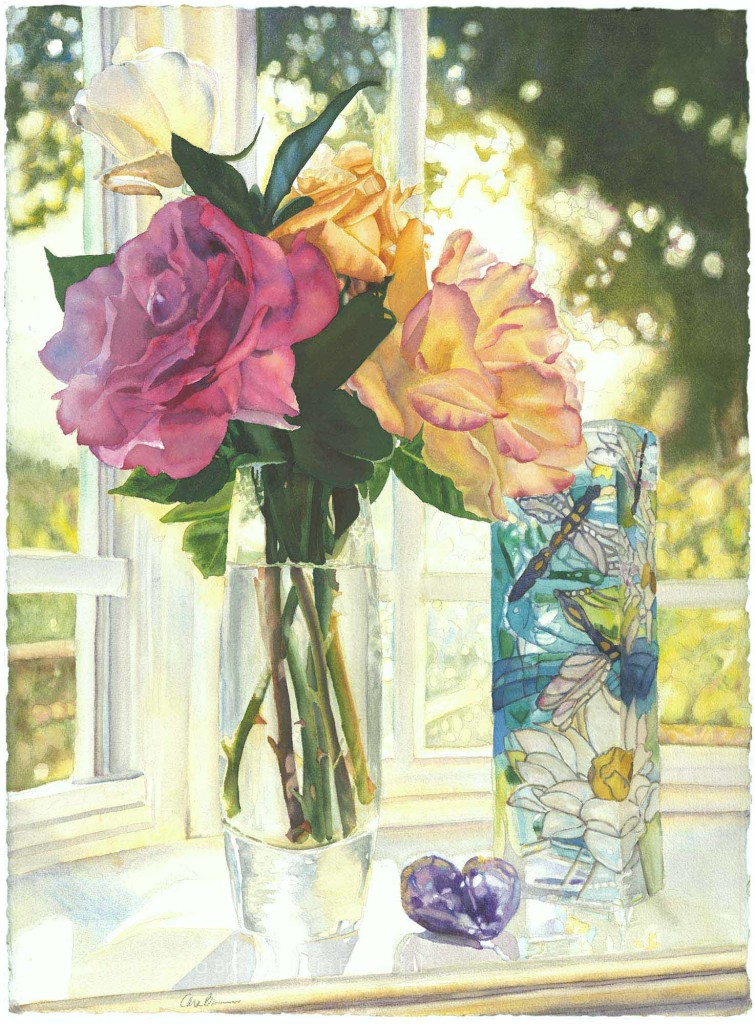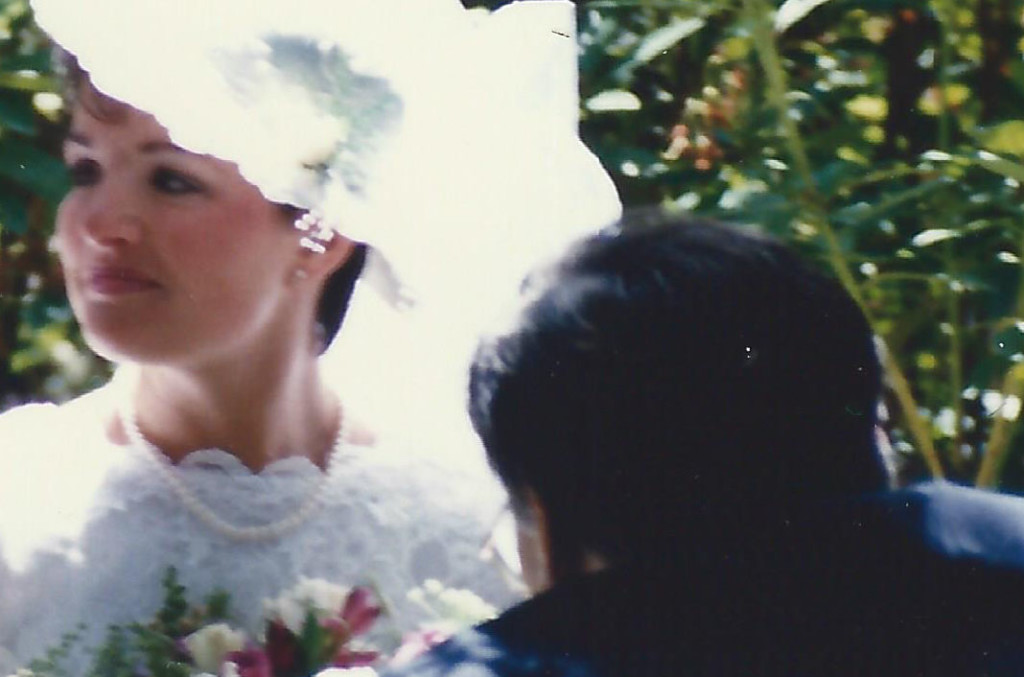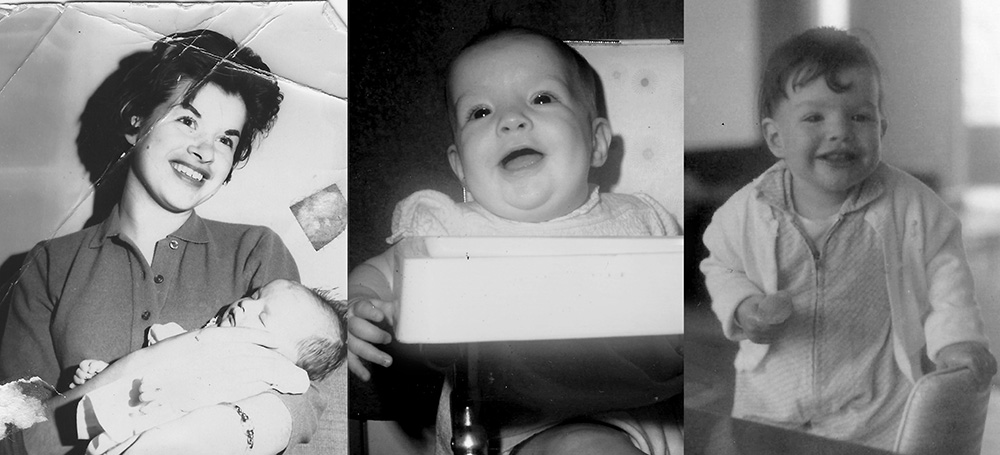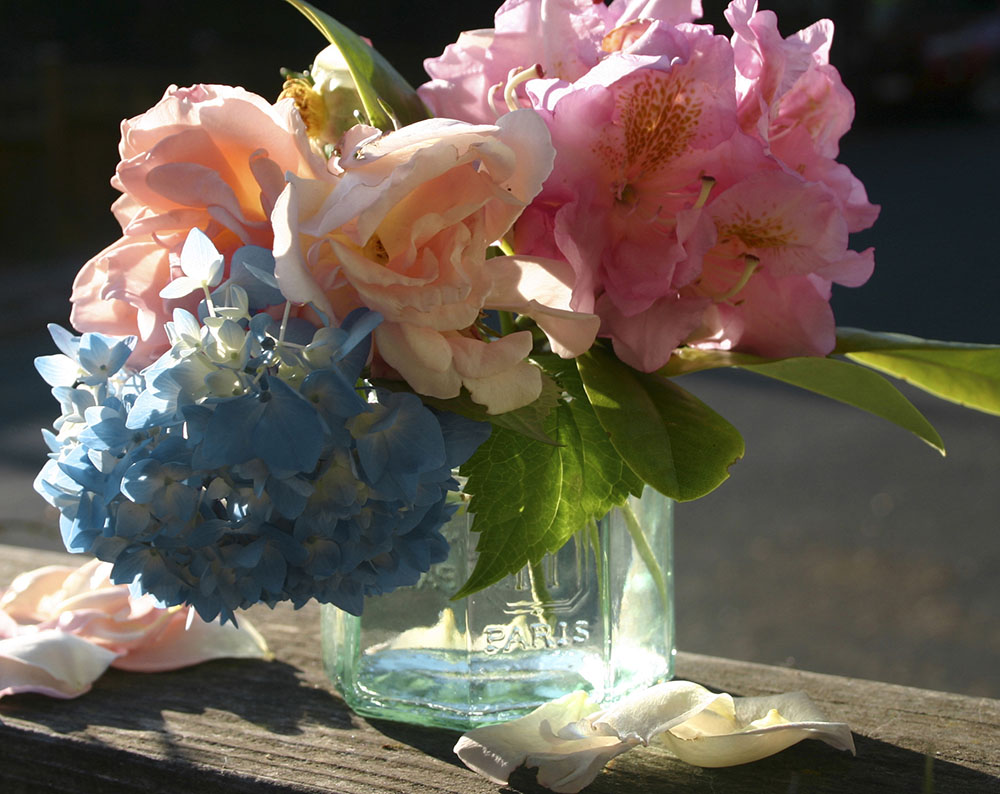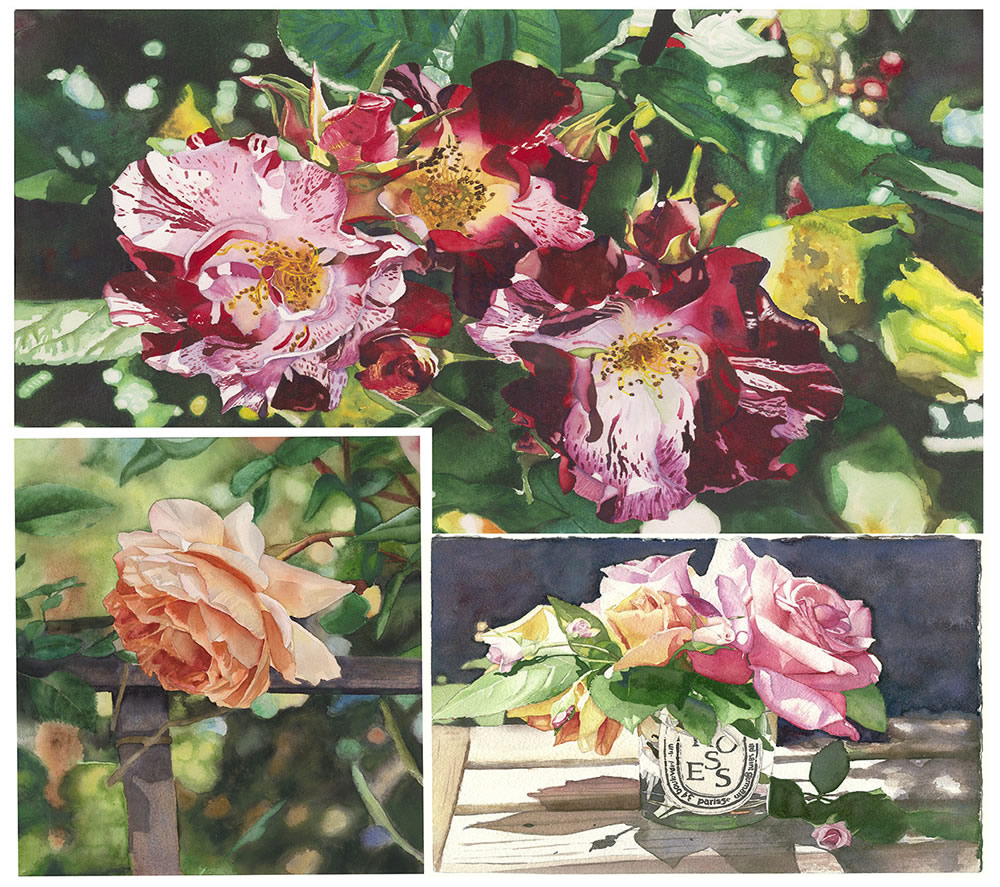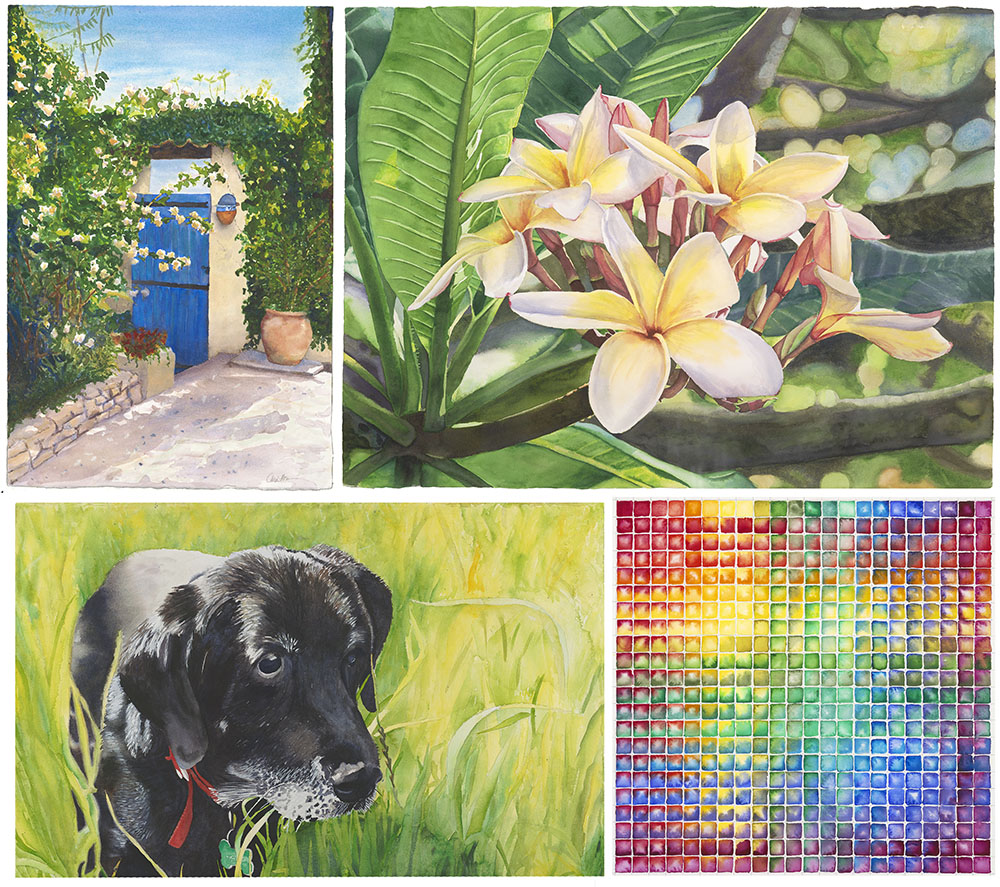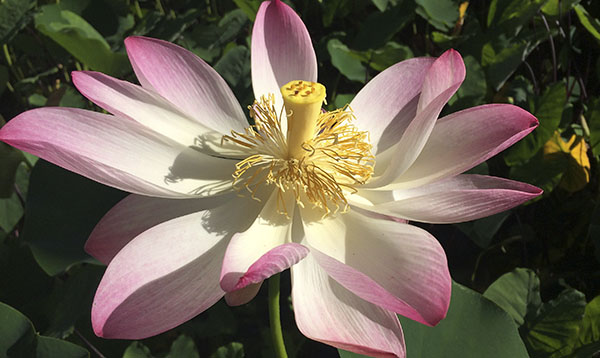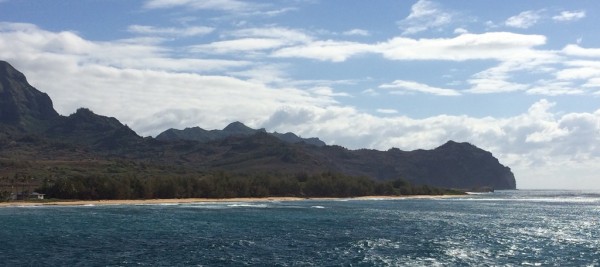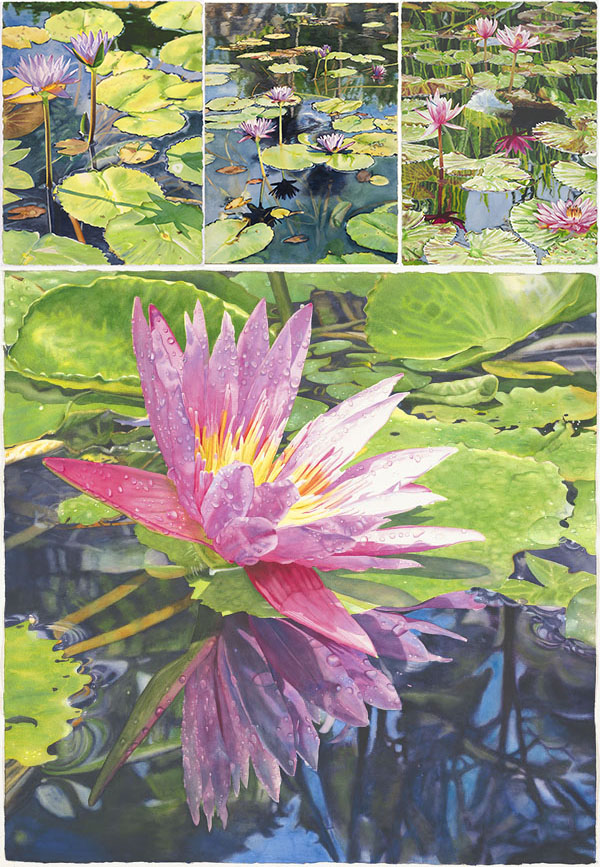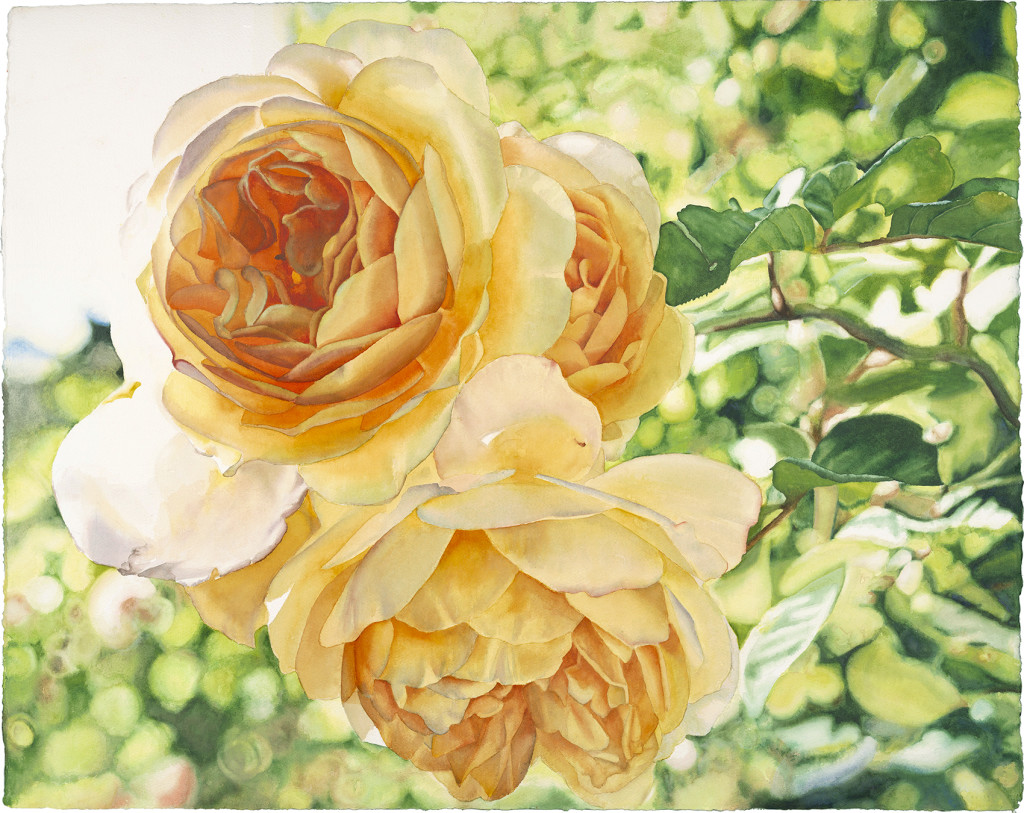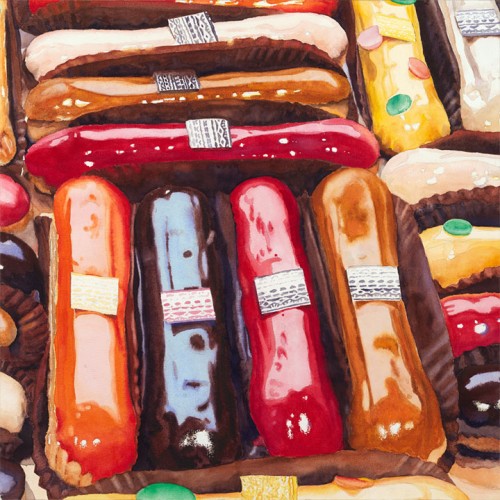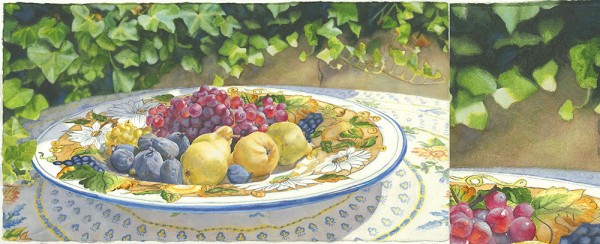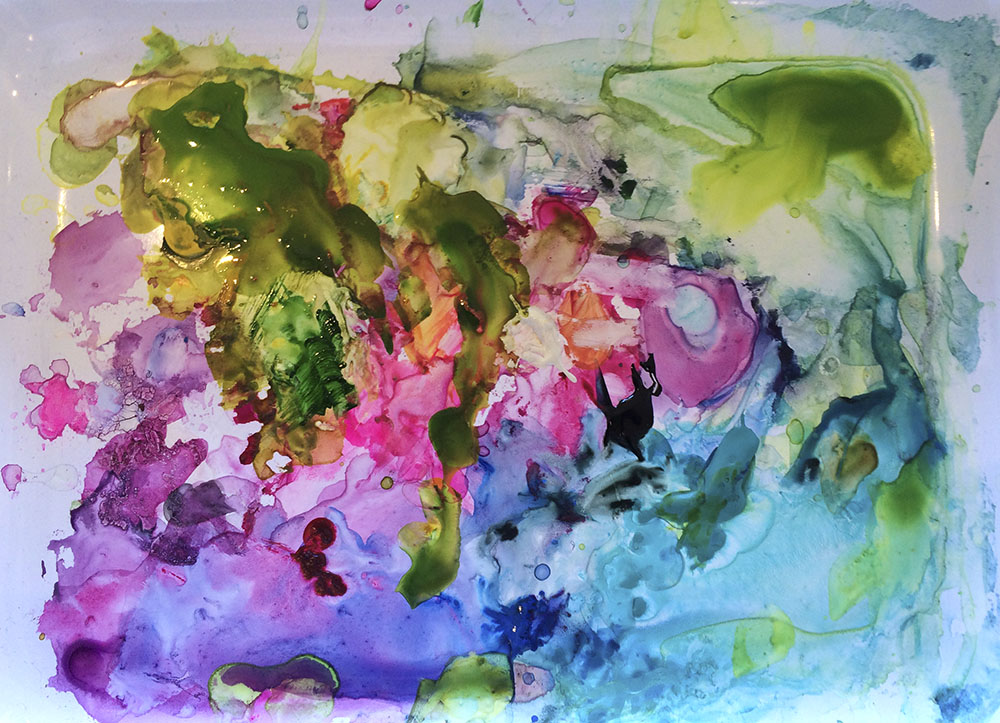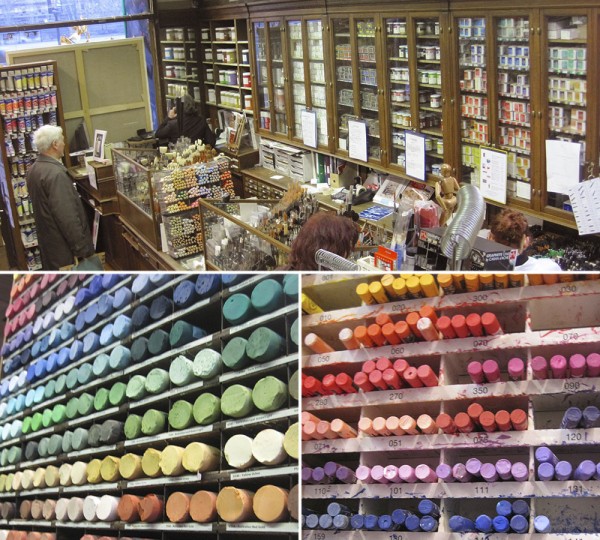July 7, 2015 – Being is believing
- At July 7, 2015
- By Cara
- In Life Stories

Listen to this post:
This past weekend was our annual summertime county fair. The Marin County Fair has a very fine Fine Art Exhibition – people involved in putting it on say it’s the best in the state – or even the country. I have no idea how true this is, but I do know it’s always an exceptional show. Juried by artists from outside our area, it receives thousands of pieces of artwork from artists from all over the Bay Area and a much smaller number are accepted for the five-day show.
This is where I first publicly showed my work – Paris Roses was accepted in this exhibit in 2006. My watercolors have been so very well recognized in the years since. I’ve been Artist of the Year, received the special, Barbara McQuaid award, received three First Place, Watermedia ribbons, a Second place and a number of Honorable Mentions and sponsored awards.
But this year was by far the most gratifying for me. There were 26 watercolors that were accepted by 12 of the artists who paint with me. Twelve artists! Some of them have had work in the fair for longer than I have, but for some of them, this was their first time entering. My mom and I each had three pieces too, bringing the number of watercolor paintings in the show to 31 that were connected, in part, to 537 Magnolia Avenue in Larkspur – where we gather to paint almost every week.
It was almost surreal for me to walk through the exhibit and see all this beautiful artwork that I witnessed coming to be – and even more incredible that that the artists who painted them entrusted me to ask for my input along the way. It occurred to me through this experience that we have become a community.
So, we’ve been playing with calling ourselves the “537 Magnolia Painters” inspired by Dave Egger’s 826 Valencia in the city (San Francisco), the space he created to support young writers. The recognition that we are a community has come from outside us too. Charlie Barboni, the Fair Manager has invited the group of us to do a floral show in the large passageway outside the fair office where the Showcase Theater is. For any of you who went to the fair, it’s where the art chair exhibit was this past weekend. We’re going to have our first collective show this summer!
This September will mark four years that I’ve been leading these groups, which has given me the opportunity to observe the inner process that we all go through as we make art. I’ve also read some of what others have to say about it. Steven Pressfield’s “The War of Art” sparked the idea that we don’t choose the art we make, it chooses us. What seems to have happened now, is that I’ve formed a philosophy about how we are best treated as we go through the vulnerable process of learning our craft (which is never-ending) allowing us to reveal the artwork that is in us. And I am certain that this has helped to form the community that has gathered at 537 Magnolia.
All of this has connected to something that I read in a recent Kelly Flanagan post. He wrote about friendship and the impact of someone believing in him. It changes who we are and what we are capable of to have someone believe in us. I see how strongly I believe in the artists in this community – often before they believe in themselves. I’ve written plenty in this space about the voices in our heads that seem to interfere in the process of our making our artwork – which can be especially intrusive at first, before we have any proof that there’s any reason for our efforts! Believing in ourselves when we are starting out can be really hard! Having a strong desire to make art that is really pleasing to us just makes it harder. We care a whole lot about the outcome, and our early work can sometimes be far from what we want it to look like.
I know I’m not alone in being constrained by the “who are you to…?” voice inside. That voice has its place – to keep us safe. But it makes believing in ourselves impossible at times. I don’t go it alone either. I’m part of a coaching group that meets over the phone every other week to share our challenges and successes as we create our work in the world. My coach, Lissa Boles and my coaching “sisters” – as we call each other – believe in me before I can in myself.
And, what is occurring to me now is how it has changed me to believe in these artists who form this community. It seems rather natural to believe in someone who believes in themselves. There’s a confidence, a flow to enter into. But, it takes boldness, even audacity to believe in someone in the face of their not believing in themselves. There has to be some-one doing the believing – to have a sort of internal solidness to anchor this position. I get to say that I you matter to me, and what you are up to matters to me and that it is absolutely worth your doing – and then sharing it with the world.
I was introduced to the idea of sovereignty by Mark Silver, a business coach who is also a Sufi master. And I love this idea – a state, a country, of me. I looked it up – here are some synonyms: autonomy, independence, self-government, self-rule, self-determination, freedom. Maybe because I’m a feminine creature, oriented to what’s outside me, and maybe it’s just how I came through in this life, but I’ve spent most of my life so far from the idea that I could be sovereign. It’s a remarkable experience to be growing into it now.
I feel a sense of real strength – a sense that who I am has impact – as I embody my philosophy of how artists are best supported and by believing in them. It even helps me know that I exist in a more real way. I know I am because I’m someone who believes in others. Sunday I spent a lot of the day organizing photos on my computer. I take pictures of everyone’s paintings each week, as they are in process. Among them were many work-in-progress photos of the same beautiful paintings I saw on the walls of the exhibit hall the day before. It is such an honor to be witness to all of this – the unfolding of the paintings and their creators. I can’t imagine a better way to spend this life.
Love,
Cara
June 30, 2015 – The Space for Grace
- At June 30, 2015
- By Cara
- In Life Stories

Listen to this post:
I did the San Anselmo Art and Wine festival this past weekend. It’s where I showed my work for the first time at a street festival in 2007 – this is my ninth year running. On Sunday morning, I was walking down Magnolia Avenue to my booth to get it all set up again for the day. My body felt so tired and my mind was telling me that I really need to consider whether doing these shows is still worthwhile. Many years ago, this particular festival was a really nice one. It was filled with all kinds of really nice art. As have many street fairs, the economics are such that the majority of the vendors are not fine artists – in fact many are not even crafts people. I’ve had dreams of it returning to its glory, so I’ve been sticking it out. Saturday I had sold some mugs and cards, but only two small prints all day. Walking along I was asking myself if it is still worth it. I even called my dad on my cell phone asking him to remind me of how hard this is on me when I think about doing another show.
Then I heard somebody call my name. It was a friend of Joe’s. We call him “Uncle Bill.” He’s a big bear of a guy – a contractor who is does just beautiful woodwork – and he’s a big love. He lives on Magnolia – I’ve painted one of his roses, the painting I call “Faith.” As we stood there on either side of the beautiful new wooden gate he made, he told me about someone he golfs with – a man named Gordon who is in his 90’s. Gordon told Bill that he actually pinches himself every morning when he wakes up – to check to see if he’s still here. He reminds Bill that every day on this side of the grass is a gift. Ok, that’s my reframe. I get to go share my art with the people who come to the festival today.
Minutes later, I started taking down the side-walls of the canopy – forty feet of eight foot high plastic tarps that zip together to close up the booth overnight. I was standing on my stool (I forgot to pack the step-ladder!) as I’m shaking out the crumples, attempting to gather it all to fold it up, when a woman walks by, very nicely dressed, lovely in black and white, a hat, heels and pearls. With a smile and an offer to help, she picked up the other end of the tarp, immediately intuiting how I wanted it folded. Instead of my fumbling around by myself, her help made it quick and easy. What a Godsend! I asked if I could offer her some notecards or a mug in appreciation. She said, “how about a hug?” Wow. Such graciousness and it wasn’t even 9:30 in the morning!
A few hours later a couple came in, they were looking at all sizes of the prints of August Bounty as they talked about walls and spaces. They seemed happy discussing between just the two of them, so I let them be. Then he handed me a credit card and said they’d like that one. I asked what size – they said no, the original painting. OMG! It’s still surreal to me when this happens. I hope I never get over the excitement of someone giving a home to these pieces that I spend all these hours on, putting so much of myself into. After we agreed I’d take it to them after the show, they left. A while later they came back by and he said to me that he feels like he just gained a new child – huge smiles. So happy! Ok, so by now I have a completely new perspective on whether or not these festivals are “worth it.”
Saturday evening – the night before all of this – at my mom’s recommendation, I watched President Obama’s moving eulogy at the service of Rev. Clementa Pinckney – the pastor at the church in Charleston who was gunned down. He spoke powerfully and with great heart of “grace.” I heard our president actually speak these words: we don’t deserve grace, there’s nothing we can do to earn it – we are all sinners. Not what I’d expect to hear from the leader of our country. This is potent and evolved wisdom that’s not easy for many to hear much less take in. I hear the same message from one of my spiritual heroes, Father Richard Rohr. We are all deserving and undeserving. Deserving by virtue that we are all an expression of the divine – every single one of us. And undeserving because it’s not a meritocracy. There’s no need to do good deeds to be eligible for grace. Grace is even bestowed upon those who appear completely undeserving – as the families of the shooting victims demonstrated in their refusing to hate their loved-one’s suspected killer – instead, in their unspeakable grief, offering him their forgiveness. I was just stunned by this.
People who are very close to me are in recovery groups – 12-step programs. Through them I hear of others who struggle, who have a really hard time staying clean and sober. I think about this often. How is it that some people hit bottom, end up in recovery, work the program and experience real transformation? One day at a time, they seem to never look back. And others want to, but still struggle to get and stay sober? It’s not willpower. It seems to me this is where grace comes in. Grace allows the spiritual shift in perspective that enables us to pick ourselves up from within our darkness and seek the light. It’s grace that helps us change our minds and hearts and see our connection to everything, it’s grace that opens a crack in our defenses – which keep us safe, but also keep us isolated.
Talking with Uncle Bill, being rescued in my chore of folding up the tarps and having August Bounty find its home were all tiny acts of grace in my life. Not exactly life-changing – like forgiving heinous acts of violence or someone taking the steps toward sobriety or my finding the courage to leave my first marriage, but it is this-moment-of-life-changing in a complete shift in my perspective on a Sunday morning. Grace is delivered through those around us – and church can happen anywhere.
But it seems that there’s no need for grace without the lack of it, without suffering – without addiction, without harboring hatred, even without just a grumpy mood. This is one of these deals of incarnation. It comes with the territory of living a human life. We will suffer – in small ways I can suffer daily! I find myself stuck in the point-of-view of my small self. Grace will come to my rescue as long as I let it. As long as I am willing to open a space, surrender my small-self from being “in charge” and allow it to seep in, soften me and expand my heart and thus my perspective. It’s my experience that grace can become a habit. Now that I’ve experienced it enough, the shift from stuck to grace can happen more easily. And I’m so grateful for everyone in my life – including you reading this – and your deliveries of grace to me. Thank you.
Love,
Cara
June 23, 2015 – Books that pulled me along
- At June 23, 2015
- By Cara
- In Life Stories

Recording of post coming soon.
I was married for the first time when I was 25. My college boyfriend and I asked my dad’s oldest friend, Jerry Lucey to perform our ceremony. He was incredibly well-read, could recite Irish poetry and had an amazing presence. He was a Universal Life Church minister and ours was not his first wedding to preside over. Since neither one of us had any affiliation with any minister or judge, having Jerry marry us made perfect sense. When we met with him in his flat in the city (San Francisco) to talk about the ceremony I told Jerry I wanted no mention of “God.” God meant nothing to me – or my fiancé. The Paul Stookey song “There is Love” was the only way God was mentioned on June 27, 1987. As I look back, this stands out very clearly to me as ground zero in my spiritual journey. The next eight years played out with alcoholism and co-dependency, the pain of which brought me to my knees. And it gave me my inner life.
I get many of the inspirations for what to write on Tuesdays when I’m lying in bed, just barely awake. Yesterday I was thinking about the dozens of books that have contributed pieces to the unfolding of my inner life, my growth. I thought I’d share a few of them with you.
I have no idea how I was led to the first one, but I read “The Celestine Prophecy” in 1994. This book dawned in me the awareness of other dimensions of existence beyond the physical world, as well as other forces at work beyond my conscious mind and will. It was here that I first heard of “energy” in its new-age sense. Shortly after that, I was lead to Marianne Williamson’s “A Return to Love,” her book on The Course in Miracles, which helped me start to realize that I there might be a point to how hard my life felt.
I was still in Burlingame – where I lived in my first marriage – when was introduced to Pema Chodron! I wish I could remember how I was led to “The Wisdom of No Escape.” Thumbing through it now, it’s astonishing that I encountered this wisdom so early in my process. I imagine my self-back-then reading this passage: “We see how beautiful and wonderful and amazing things are, and we see how caught up we are. It isn’t that one is the bad part and one is the good part, but that it’s a kind of interesting, smelly, rich, fertile mess of stuff. When it’s all mixed up together, it’s us: humanness. … Both the brilliance and the suffering are here all the time; they interpenetrate each other.” All I saw at that point was that it was all “bad” – that there could be something “good” for me in it helped me see that my panic attacks could be telling me something.
Of course this list includes Julia Cameron’s “The Artist’s Way.” Because of this book, I wrote Morning Pages for the five years from about 1995-2000 – from just before leaving my first marriage until Joe and I were married. These were years I chose my self, I chose my life – which I don’t think would have been possible without Morning Pages. And I still take strength and direction from this passage: “Anger is the firestorm that signals the death our old life. Anger is the fuel that propels us into our new one.”
The crack in my belief that life was “being done to me” started my transformation. The next few years included separation, divorce, living in Paris, and then coming home, facing my loneliness – I had the hardest time being single. And then in 2003-2004 infertility spurned a second big “wave” of change in me – leaving a career that was so far outside my feminine soul’s call.
Sue Monk Kidd talked about her fears in her spiritual memoir, “The Dance of the Dissident Daughter.” She had a successful career as a Christian writer, which had become her identity. But then there was this voice. “There is this other clamoring in me, too. The desire I’ve carried around but never dared. The thing I thought I could never do. Now here it is. The urge to create characters and stories. The ones that are mine to tell. Fiction, the passion tells me. Fiction. …I cannot stop thinking how brave I will have to be to follow it.” And what came out was the New York Times bestseller, “The Secret Life of Bees!” Ok, I get it, these voices must be listened to! And I must listen to mine!
Ekhart Tolle’s first spiritual blockbuster “The Power of Now” played a part for me – life is all about our consciousness unfolding. In his book “A New Earth” it is this passage that has me understand why so many of us are drawn to flowers: “Earth, 114 million years ago, one morning just after sunrise: The first flower ever to appear on the planet opens up to receive the rays of the sun….Seeing beauty in a flower could awaken humans, however briefly, to the beauty that is an essential part of their own innermost being, their true nature. The first recognition of beauty was one of the most significant events in the evolution of human consciousness.” I’m now fully validated, painting flowers is not trivial in any way, it’s in fact right at the center of our evolution! Oh, is that all?
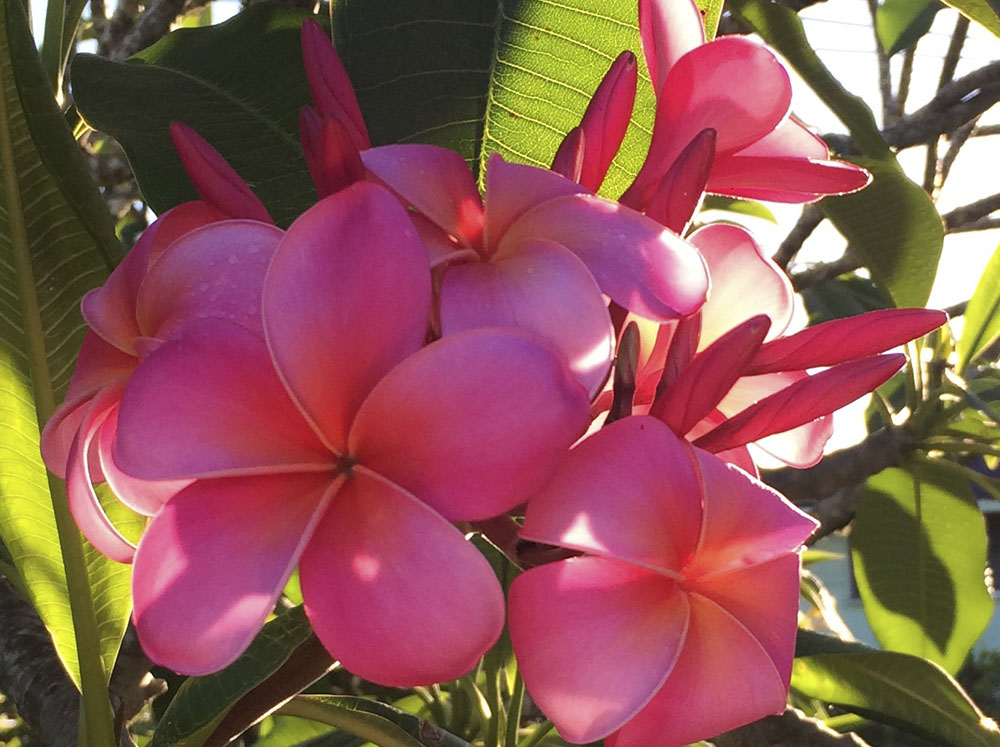
The pink plumeria tree from the garden where we stayed in Kauai last month. Future painting … stay tuned.
I love skipping to the end of newspaper articles, magazine stories and books. I have read Steven Pressfield’s “The Wart of Art” all the way through, and much of it over and over, the end is worth reading all on its own – it’s a call to answer our call.
“Are you a born writer? Were you put on earth to be a painter, a scientist, an apostle of peace? In the end the question can only be answered by action. Do it or don’t do it. It may help to think of it this way: If you were meant to cure cancer or write a symphony or crack cold fusion and you don’t do it, you not only hurt yourself, even destroy yourself. You hurt your children. You hurt me. You hurt the planet. You shame the angels who watch over you and you spite the Almighty, who created you and only you with your unique gifts, for the sole purpose of nudging the human race one millimeter farther along its path back to God. Creative work is not a selfish act, or a bid for attention on the part of the actor. It’s a gift to the world and every living being in it. Don’t cheat us of your contribution. Give us what you’ve got.”
These are just a few of the passages that I keep going back to. There are many more books that have made their contribution to me. A few more follow at the end of this post.
It’s incredible for me to reflect on the woman I was 28 years ago this coming weekend. The God that my 25-year-old-self had no place for was a God based on my outsider’s understanding of Judeo-Christian religion. The God that is now at the center of everything for me is a God that is so much bigger, so much deeper and integral to all that is. I’m truly grateful for all the pain and suffering that has loosened me from my dug-in stance that all the answers come from my rational brain and has allowed me to progressively surrender to a knowing that I, you, we are all expressions of this energy, this force, expressions of God. And our lives, our joys, our suffering – including all we create – are a reflection of our progress towards our true nature – our beauty. God is in and through these books. I’m grateful to their authors for bringing them through.
Love,
Care
A few more books:
• The Millionth Circle – by Jean Shinoda Bolen – the hundredth monkey story is worth the whole book.
• Eat Pray Love – by Elizabeth Gilbert – ok, so who spends months in Rome and only goes to one museum, the Museum of Pasta!? I love the permission to prioritize pleasure!
• A Path with Heart – by Jack Kornfield – I once did a short meditation from this book for about an hour while on a bus returning home from the city. I got off the bus and all the flowers were extra clear, sharp and vibrant – it altered my consciousness!
• Wouldn’t Take Nothin for this Journey Now – By Maya Angelou – her sovereignty emboldens me.
• Gifts from the Sea – by Anne Morrow Lindburg – just poetry.
• The Naked Now – by Richard Rohr – the idea of non-dual thinking has brought immense peace.
• All of Anne Lamott’s non-fiction – every single one. Bird by Bird’s chapter title “Shitty First Drafts” allowed me to let myself write – something I told myself I was incapable of.
• Art and Fear – by David Bayles and Ted Orland – this book affirms everything I observe in myself and others as we make art and even attempt to live a creative life.
June 16, 2015 – Dancing with dying
- At June 16, 2015
- By Cara
- In Life Stories

Listen to this post:
When I was a baby I was really sick – I had a heart defect. When we are in utero, there is a shunt in the circulatory system that surrounds our hearts that is supposed to close shortly after we’re born. For unknown reasons, mine didn’t. This set up an abnormal blood flow around my heart, that meant that any little cold or other bug I got, collected in the shunt and sent a germ-bomb into in my lungs, which gave me several bouts of pneumonia. Five times I ended up hospitalized in an oxygen tent. My family’s pediatrician, Dr. Stan Mogerman at Kaiser in San Francisco most likely saved my life. The normal protocol was to wait until the child is five, to see if it may still close on its own, but he insisted that I have the surgery at two and a half. The surgeon, who operated on me – the first ever done at Kaiser SF, said that I would not have made it to five.
When I was about 30 I discovered that my grandparents had taken a life insurance policy out on me. They were afraid that if I died, my parents wouldn’t have the money to bury me. My dad was finishing college and our family had no extra money. Wow, it was serious! I have only one little memory of any of it – I was in the hospital with my mom and was given a sugar donut and a small carton of milk. I have a big scar in between my ribs under my left arm that goes up toward my shoulder blade. My heart has been evaluated a couple times and it seems I am completely normal.
But I have been really, really in fear of dying a lot of my life. I have no idea if this fear came from the trauma that my little being experienced, or if the fear developed and I associate it because of hearing about all that happened to me. My intuitive sense is that it’s the former. Regardless, the fear has been very real. For a few years after a car accident, I had flashes of terrible car accidents while I was driving. I am not comfortable in airplanes – not so much that it prevents me from flying, but enough that I am very relieved when we land. And this is a bummer – my husband is a pilot! More recently, with all the changes in my body in menopause, I have fears that I could be having a heart attack or stomach cancer… Being afraid of dying has been so tiresome.
All that life gives us, though, is fodder for spiritual evolution. In early 2001, I did a year-long program with my church based on Steven Levine’s book “One Year to Live.” Our pastor, Sara accompanied a small group of us on a year living (as much as we can, artificially) as if it were our last. I was hoping to make peace with my mortality. A sentence I read in the book has stuck with me and consoles me: “Dying is safe.” The group was a great experience, but it didn’t erase my fears.
About two months ago, I was having body work done at the hands of Kathryn Hood, a structural re-integration practitioner who has magical hands. I was so deeply relaxed in a way that I don’t ever remember being, and I had the thought that I hope that dying is like this. I seemed as if I could just float off in that moment, away from the physical plane and it would be just fine. Sweet even. She is a gifted healer (she’s the first person in over 50 years to notice my surgery scar and think that the tissues around it might need some attention!), but I it was wonderful to realize that I could experience that level of peace and acceptance about my own death – that I could think about dying without this fear that has plagued me so much. The fear is not gone, but I can draw from the memory of this experience. I know this peace is in me. And I love what Kate said when I told her. She holds that this level of deep peace can be how we live!
It seems that it’s every couple of weeks these days that we hear of someone, a beloved of someone we know, who has died. Some have lived a full, long life, but many are not that much older than I am. It can happen really quickly. Not just accidents, but heart attacks and even some cancers can kill us in a few months. It’s impossible to not consider my own death when hearing this news. What comes to me now when I consider dying anytime soon is: but there are paintings in me! I don’t have so much a bucket list of experiences, as the sense that there is work in me that needs to be created. I don’t know exactly whose “need” this is – but I feel it. Creative work is connected to the life-force, to the spirit that animates all life, everywhere – the entire universe. I deeply believe that as long as we are alive, we are a channel for this creative force. It is my experience that it is imperative to our well-being, to our well-living to give this force an outlet – especially once we have awakened to its presence in us.
There is a balance. There is a duality inherent in our lives: we will all die, and in this moment we are alive. I don’t want to fearfully obsess on death, but a wholesome presence to it gives me the capacity to hold the preciousness of this life I’m living. From there I am much less apt to get mired in all that doesn’t matter so much. And I can hopefully choose to spend my time in a way that honors its finitude – mostly this is about remembering to be grateful for the moment I am in. Like this one: Bo is softly breathing next to me on the bed, my fingers adept at typing on the computer, thinking about my husband out doing his day. And – thinking about you who will be reading this later. It’s also about anticipating my life to come – living expecting to keep on living.
In a few minutes I’ll get up and get out for some exercise with Bo. As I imagine my day, I probably won’t think much about dying. The painting I’ve just started is calling to me. I will work on it, and I will work with my Tuesday student. I will post the painting I just finished on my website and pay the credit card bill that’s due. Later, I’ll cook food for us and cuddle with my Joe and my Bo. It’s almost hard to fathom how we can have the capacity for both: to be contemplative – present to the preciousness of life, we don’t know how soon, but we will die – and to do all the things on the list – as well making our list expecting tomorrow. What I’m grateful for at this point in my evolution, is that in my best moments, there is the capacity to hold both at the same time.
Love,
Cara
June 9, 2015 – The gift in our unlived life
- At June 9, 2015
- By Cara
- In Life Stories

Listen to this post:
It was the summer of 2003. Joe and I had spent the weekend at a little beach house in Stinson Beach – on the coast of Marin County near where we live. He went home to work on Monday and I stayed two more days by myself. It was a tender time – we were in the middle of sorting out whether or not to do a course of in-vitro fertilization. It was a cool late afternoon – the fog was coming back in. I wrapped the little blanket I was sitting on up over my bare legs. The cell coverage was better out on the beach than in the beach house. So, it was there I talked to the fertility doctor for the first time. He was very gentle but matter-of-fact. This was going to be expensive, not covered by medical insurance, and at my age – (then I was 41), we had a far less than 50% chance of success. I remember getting off the phone with the fleeting thought: this might not work – I might never have any children. It’s remarkable how protective denial is. I was so emotionally ill-prepared to handle that very real possibility that I had the capacity to just put it out of my mind – like it was an awful sight that I could avert my eyes from. I just couldn’t go there. Buried in that denial was the fear that the disappointment, the grief I’d feel, would completely devastate me.
You know how this story came out. We did IVF and I didn’t get pregnant. Four eggs were harvested from my ovary, one four-celled embryo was implanted in my uterus (we have a Polaroid picture of it – labeled “Greenwood-Brown”). It didn’t take. And the grief came. I felt it and avoided it and then it stalked me, until I felt it some more. I’m nowhere near as raw as I was then, but if I go looking for it, it is right there. I suspect that it might always be. As a woman, I have all this amazing physiology that I will never use, never feel my baby kick inside me, never endure the agony of childbirth, never look into that brand new little human’s eyes or ever be called “Mommy.”
If you are wondering, yes, we thought about adoption and yes, there are plenty of other children that I could have given (and still could give) my love and attention to. And, I completely get how parenthood brings with it a whole lot of hard work and even grief of its own. Neither of these places are where I’m going here.
There’s a book in my collection by Dawna Markova called “I Will Not Die an Unlived Life.” She awoke in the middle of the night, the exact moment when her father died. What came to her in this moment was: “I will not die an unlived life. I will not live in fear of falling or catching fire….” It goes on. The message of the book is powerful – “Reclaiming Purpose and Passion” is the subtitle. I’ve read this book through, have shared from it and quoted from it. It’s been part of my unfolding.
But, the thing is, I think we all do have an unlived life. My dad recently told me that he missed out on the going-away-to-college experience. My mom has always loved technology – she had the domain name niz.com in 1995! But, because someone at IBM in 1959 told her she had no aptitude for it, she shied away. Can you imagine what my force-of-nature mother might have done if she’d gotten involved in tech when it was in its infancy? Two of my spiritual mothers have lived each other’s unlived lives: one the sensuous marriage to her soul mate, the other a life of contemplation and spiritual exploration. My unlived life is motherhood.
It may not be so for all of us – but I am still very conscious of the life I didn’t get. On the practical level it left space and time to focus on something else. But it also brought with it a well of painful emotion that has fueled me to persevere. The circumstances in my life and my internal wiring were such that going back to a “real job” retained a serious pull on me for many years. This immense disappointment has sat right over my shoulder, waiting to come barreling through if I were to cave in on living a more fulfilling life.
It has done its job. I could not have made this up. I had no idea this art was in me and would end up saving my life – or that I had the capacity to accompany others in the process of their art saving their lives. But now it’s hard to imagine there’s anything else I am better suited for.
Sunday afternoon I had a two-hour talk on the phone with Brenda, my friend of 30 years. It was a fierce conversation. In the most loving way she admonished me to care for my endeavors – art, teaching, my work – as if it were my child. She said that my allowing myself to be pulled away by other demands upon me was like neglecting to change my baby’s diaper. It was Brenda who watched me pull a plastic bag of unframed paintings out from the dark and dusty space under my bed. She told me that I had to get them framed and hung for people to see. I had been afraid of spending the money to do this – didn’t know they were worth the investment. She said I must. The paintings above and here were the ones that were in hiding.
It’s long since time when having a baby has even been possible for my body and I am at peace with that. Sometime last year I spent a few hours with my dear friend Julia’s toddler. We had the best time, reading books and drawing. When Julia came to get her, as they left, I noticed that I was ok, I was good. I no longer longed. That part of life had passed by. I felt like a grandma – in the sweetest way.
I believe that this unlived life has wrapped itself around and through my lived life. None of this would have come to be without what I did not get in this life. Unlived lives have energy and power. They call upon us to honor them, to listen to them. Mine is very real and clear to me. It has demanded my attention. With the help of my dear friend, it reminds me to fully inhabit what I got instead, and points out the incredible richness of the life I am living. You are part of this richness. As I write this, I am washed over with a wave of gratitude that breaks me open.
Love,
Cara
June 2, 2015 – The spirit of Kauai
- At June 2, 2015
- By Cara
- In Art in Process, Life Stories

Listen to this post:
I first came to Kauai about this time of year in 1997 for a friend’s wedding. I stayed at the Hyatt Regency – a beautiful, lavish resort on the south shore. I had United MileagePlus discount coupons for this hotel – it’s funny how accidents of circumstance can end up changing our lives! I had been back a year and a half from Paris and hadn’t yet met Joe, so I was here on my own, amongst lots of shiny wedding bands and families with small children. My friend’s wedding was in a garden along Hanalei Bay on the north shore and we went to a luau on the east side – giving me a taste of a lot of this lovely island.
The next time back was two years later. Joe had just finished chemo and we were looking for a vacation spot to start his healing. He’d been to Maui, but never Kauai. My first trip here introduced me to Kauai’s rhythms – peaceful and soothing. We stayed in an end-unit condo with a sweet, private little garden, walking distance from the Hyatt where I had stayed. We discovered a hike along the coast, starting at Shipwreck Beach in front of the Hyatt. The web of trails head east along a bluff, with amazing views of the ocean and the south coastline of Kauai. We hiked every morning and then came back and talked, really talked. His journey through cancer treatment started six days after our first date and the next six months were a whir of emotions and the realities of cancer treatment – infusions, a hospital stay, injections at home, many restless nights. In that little garden condo we took the time to share with each other at Kauai’s pace.
Journeys through life-threatening illness shift things in us – after cancer, Joe resolved that we’d come to Hawaii often. Since then, it’s been at least once, many times twice a year. Except for one more trip to Maui and another to the Big Island – both in the following two years – every trip back has been to Kauai. In 2004, on a whim, we walked into Island Pacific Properties in Koloa town and met the broker, Stephanie. We left that trip having taken a big risk – we’d made an offer on a house! It’s always been someone else’s home, we’ve never furnished it so that we could stay there, but owning a house on Kauai has anchored us here even more. What seems more important to me is that through Steff, we’ve met so many wonderful people. When we come here now, we see old and new friends. It’s so much more than a vacation spot.
Because we really love sunshine, we’ve always stayed on the south shore. I’ve been here 10 days now and I’ve not ventured any further north than the airport in Lihue! Our time here is spent “trying on” retirement. We’ve always stayed in a place with a kitchen, so we can have meals “at home” if we want. We still do the same walk along the coast, but now we know to look for sea turtles in the water and often go all the way to the next beach – Mahaulepu – and go for a swim in the spot inside the reef break. On calm days it’s almost like a swimming pool. Joe golfs and I paint, we read and do a whole lot of not much else. There are many treasures on this island we’ve yet to experience, but somehow we’ve lost the impetus to be explorers. What we come here for, more than anything else, is to just be.
I take walks along the shore from the Hyatt headed west sometimes too – and take pictures of the tropical flowers in the lush gardens of the resorts and vacation homes. So many of my paintings have come from these walks.
It’s been interesting to watch things change: new condos have been built in some of the empty spots, run-down places re-done and the gardens change too. For some reason, every year for the past five or so, the water lily ponds are going away. One year there are no more plants, the next there isn’t even any water in them. I don’t know if they are too much to keep up, but I’m so glad that I have been able to capture them in paint! None of the ponds I’ve painted below exist anymore.
As I mentioned in my post about “home” a few weeks ago, Kauai is one of ours. It has me wonder what it is about a place, the spirit of a place – that meets us, compelling us to come back again and again, developing a relationship with the place that is as real as any relationship. As I write this, I’m in my friend Robin’s studio – in her house in Kalaheo – a bit up-country from where we stay closer to the ocean. She paints beautiful, color-filled oils of this heavenly place. I love having a real artist-friend here. We inspire and support each other in a way that, somehow, I’ve not found with anyone at home. She’s working on a painting of a succulent, finding her way through the shapes and colors and I’m taking a break from struggling through the lily pond painting I’m working on to write to you. Coming through the open French door are the sounds of the breeze in the palm fronds and the calls of the tropical birds – including the roosters – and even the bleat of a goat! This is absolutely paradise.
We’ve talked about living here full time – even as an adventure for a year. So far, the pull has not been strong enough to up-root us from Northern California, where we were both born and our lives are still centered. Nonetheless, there is something here for us, that lives in us when we are back “home.” When we went to see the George Clooney movie, “The Descendents” at the Fairfax Theater, we felt it. There is a scene where his character flies with his daughters from Oahu to Kauai to see the family property. As they are walking in from the jet-way into the Lihue airport, I felt in me and sensed in Joe a combination of recognition, knowing and longing. We felt Kauai in our bones for a moment. This place fills a need in us that isn’t filled anywhere else – even in the very-special place we live.
Saturday night we went to the salt ponds to watch the sunset. Joe was curious what the people were doing a short distance away. Following his intuition, we went to check it out. His respectful, reverent way of asking about it inspired Emma, a native Hawaiian to take the time tell us all about it. She’s the third generation that has been tending the salt beds – the only ones on Kauai. We saw how they carefully re-make the beds with smooth black mud every year and then carefully bucket the salt water from the wells into them. The sun evaporates the water and in a number of weeks salt crystals form, which are then gathered up and dried. Her son and niece and grandkids were there, participating in the traditional practice, carrying on the knowledge. When I asked if they sell the salt, with pride and honor, she told me they only give it away. Then she gave us some of her pink salt from last year – white salt that had been mixed with Hawaiian red dirt. She told us this salt is medicine.
The clouds were spitting rain as we left, feeling like we had just been blessed. It’s still not coming to me how to articulate what it is about the spirit of this part of this island that we connect to, but it so does. We are renewed and inspired here. The air is soft on my skin. Thank you, Kauai.
Aloha,
Cara
May 26, 2015 – Caring about caring
- At May 26, 2015
- By Cara
- In Life Stories

[I wrote this post while on an airplane to Kauai over the weekend. I’m posting it from here, while listening to the Hawaiian birds and feeling the balmy air on my skin. I am taking a break from recording an audio version while on vacation. I’ll resume when I’m back.]
On election night in November of 2008, while waiting for the outcome, I painted. I was finishing up a painting I ended up giving the name “Blossoming Hope” and listening to a conference call. Ali Brown, a business coach, was interviewing a woman named Alison Armstrong. The talk was billed as: “Stop Trying to Be a Man in Your Business! The Power of Femininity in the Workplace.” I was hungry to understand – and (still am) seeking to fully grasp how I can be feminine – be in the feminine and still pursue my endeavors in the world. Since building and growing are inherently action-oriented – squarely in the masculine, being an entrepreneur in a way that is grounded in the eternal, the yet-to-be manifest, being receptive and expectant continues to be somewhat an elusive balance! After that, Ali Brown drifted away for me, but I’m forever grateful I was in her world for a while, as it was she who led me to my beloved Alison.
My relationship with myself, my husband, my work, with so much has transformed because of Alison and the distinctions she makes and shares with the world. Many of these distinctions have to do with the masculine and the feminine – a theme that seems to have captivated this lifetime of mine. But some of them are more universal, more generally wise and always spiritually sound. Somewhere along the way I heard her talk about caring. That caring is a resource. My idle thoughts the past few days have picked up on this idea. What we care about: where we put our concern, our interest – our hearts – seems like something useful to explore. It seems related to another idea I came up with myself years and years ago. It occurred to me that how we pay attention and what we pay attention to has an enormous impact on who we are. Think about it; if you watch for it, you can see it everywhere.
My husband loves baseball. He reads – pays close attention – to the sporting green and follows along with lots and lots of games. His knowledge of players and their histories and performances is positively encyclopedic! The games are often on the TV or radio when I’m around, and the sporting green is there for me to read too, but I don’t. I don’t pay the attention he pays. I don’t care like he does. But I do care about his caring, so I pay enough attention to engage with him – and I am wearing SF Giants orange fuzzy socks as I type this! It’s the same with old movies, aviation information, the technicalities of how music is made – largely he is who he is because of what he puts his attention on. People who pay attention to incidents of crime are more concerned about security; people who are interested in the very best food are more discerning in their tastes than someone who is just fueling their body. What we care about, we pay attention to and it shapes us.
Looking through old photo albums when my college friend Randi was here last year, among the photos of all of us drinking huge margaritas in Tijuana and roller skating in Balboa Park in San Diego, were photos of orchids. I took photos of flowers when I was a teenager! I noticed them, I paid attention, I cared enough to stop and take pictures, even as I was studying computer science. Some of what we care about has always been there – which for me is flowers and color. And sometimes it develops over time.
Last week, I talked about how our vision changes, it’s not so much that our eyes alight upon the world differently (though I am still curious about this possibility) as much as it is our attention attuning more carefully than we had in the past. Part of this is intentional, especially at first, but then we do it unconsciously. The desire to paint has us learn to see, which then changes where we put our attention in the rest of lives as well.
Caring also gives us capacities we wouldn’t otherwise have. Doing something that challenges us takes something extra-ordinary from us in order to stick with it. Often, it’s just easier to quit. The artists in my weekly groups who have been coming to paint, week after week, show an enormous amount of care to their work – in how they work. If the painting isn’t right to them, it’s not right. Somewhere inside them is an often elusive vision for what the painting is to be. When they ask for feedback from me, near or at the end, I often hear “am I done?” They have paid so much attention to the painting that they are often tired of it. And I see over and over again, even in the face of “I’m so sick of this painting” the willingness to go back in and do one or two more things to make it really sing. Without that caring, the work does not see its full potential.
Caring about our work, and paying attention as we do it, so that we can learn the skills to realize our visions in art, enables us to make work that pleases us and that we can be proud of (or become proud of – see my post about the unwanted within). And when our work is appreciated by others can fuel the caring in us to make more work.
But caring is not a limitless resource. Caring takes energy, it’s an investment of our selves. “Paying” our attention to one thing means we can’t “spend” it on something else. We cannot possibly care and thus give our attention to all that would benefit from it. This is not a justification for burying our heads in the sand to the world’s problems as much as it is a call to consciously choose how we do pay attention. And to know that our caring matters. What we care about, put our attention to, invest ourselves in is a reflection of us.
I am constantly in the conversation with myself whether I do enough to make the world a better place. I care about the environment, I care about my relationships with Joe, my family and close friends. I care that beauty is valued in the world, I care that people feel safe and are free to express themselves. Looking at what I care about, I see that my life is a reflection of it. I don’t know how to know if this is “enough.” But for today it seems like it is. It’s worth asking ourselves – where do you put your precious attention? What do you care about?
Aloha,
Cara
May 19, 2015 – Windows to the soul
- At May 19, 2015
- By Cara
- In Art in Process, Life Stories

Listen to this post:
For some reason, I’ve been really resistant to wearing glasses to read, even as my eyes are going through the aging process that affects nearly all of us – I’m becoming far-sighted. I put off wearing drug-store cheaters to read as long as possible – until sometime after I turned fifty. And I still often go without them – squinting to see, which means sometimes I’m lectured that this will wrinkle up my face. Maybe because I’m a visual artist, maybe because what I most want to impart to the artists who come paint with me is that they can expand their capacity to see, but I’m preoccupied with vision!
Sometime last year, my dad was diagnosed with early stage macular degeneration. He was advised that all his children over 50 should be tested too. I went right in to have my eyes checked out. The optometrist found a few very small drusen on my retina, which I was told was normal for someone my age. But then later that day – a Thursday – I got a voicemail from her. She said she upon review of the photos taken, she saw a small hemorrhage on my retina. A small hemorrhage? I tried calling back, but missed her and was told that she was out on Fridays. So I spent the weekend wondering what it might be like to not have my eyes. Not only does eyesight offer us freedom and independence, but it is color and light and allows me to make my paintings! Then, I went to a Speaking Circle and realized the connection between human beings that happens when eyes meet – so much is conveyed across space from one heart to another through our eyes! I’m guessing that vision-impaired people connect hearts in other ways, as the other senses become more acute. But the thought of finding this out first-hand was crushing.
I went back to see what she saw. When the photo of my retina was expanded so it was larger than the 14” monitor, the “hemorrhage” was about the size of the head of a pin. Ok, so I’m not going to get all freaked out about that tiny thing. Whew. But the brush with the possibility of losing my eye-sight has me even more tuned in to seeing.
I was online one evening about a month and a half ago and saw one of those ads, like the-5-foods-you-should-never-eat-again. It was 10-minutes-a-day-for-one-week-to-regain-20/20-vision. It hooked me, I bit. I watched about 25 minutes of the infomercial video before the hype-i-ness of it wore me out. But I got enough information to start an online search. I found out about what’s called the “Bates Method.” Dr. Bates was an ophthalmologist, who, in around the turn of the last century, began developing exercises to help people improve their eyesight without glasses or surgery. An important aspect of this work involves resting the muscles around the eyes, which relieves strain that impairs vision.
I bought a book on it and have started, sporadically, to do some of the exercises. I’ve been almost entirely without my cheaters for over a month now. My near vision is still blurry, but it has improved slightly and I’m amazed at how I can see well enough to read – without squinting – which is itself another form of strain. One of the things they suggest you do is, when walking or driving or moving through space in some way, to look through your peripheral vision to see the trees, bushes, buildings seem as if they are in motion. When I do this, it’s as if I’m staying in one place and the rest of the world is moving by me. It’s the coolest thing! This has given me moments where I experience the three-dimensional nature of our world very acutely. On a walk with Bo in our neighborhood I saw a big tree and the space it occupies, almost as if it’s a holograph.
All of this leads me to the possibility that I can shift how it is that information is received in my brain through my eyes. It’s as if I’ve been seeking out, hunting even, visual input. What has developed is the desire to simply allow it to enter, in a more passive – yes, even feminine – way. It’s quieter, more meditative and it brings up another of the distinctions we learned in the leadership program I wrote about last week – particles and space. We spent an entire retreat attempting to focus instead of on the particles – the “things” all around us – to focus on the spaces between the things. In art it’s the “negative space.” In the big tree it’s seeing the distances between the branches as they go up and out into space. But this can be difficult – “things” captivate us – they really grab our attention with their “being-ness.”
I’m finding this challenging to articulate. It’s a shift in perspective and perception that’s hard to describe, but I’m compelled by it. I am curious as to how it might change the art that comes through me. I do know that my ability to see what’s really there, in a reference image, or in real life, has grown immensely through all these paintings I’ve done. It’s also what I most want to invite in other artists in their learning process.
Our retinas transmit 10 million bits of information every second to our brains – wow, every second? In order to not be completely overwhelmed by this information, our brains have a filter that processes that information based on what we have already seen, what we believe and value. Quite often, I watch us – yes, me too – as we make our paintings – we make decisions in color and shape and brush stroke based upon what we think we see. It takes slowing down, resting our eyes on what we are looking at, to allow what’s actually there to go beyond the filter and register in our brains.
The first time this really crystalized for me was when I was painting “Fauchon Eclairs.” My inclination was to paint the shine on the chocolate glaze a lighter version of the dark chocolate brown. But something stopped me. I made a hole in a piece of paper and put it over the shiny part of my reference image. It was a violet blue! Ok, so I trusted what I saw and painted it a violet blue. No one has ever asked me why I painted it blue, or even noticed for that matter. I can look at this painting and shift my vision from seeing shiny, brightly colored pastries to seeing abstract shapes and colors. Can you?
When I first started really painting, I noticed this shift happen all the time, even when I wasn’t trying to make art, but just going about my day. I’d see the light on a leaf and wonder how I’d paint it – or clouds, or the shine on the hardwood floor. Now, I hear the same thing over and over, from people who are new to painting, too. We really notice what is around us, even without intending to. To me this is a waking up. It’s a paying attention in a more careful and reverential, and even honest way. It makes me wonder how much our capacity to see can keep growing and what that might make possible – not just in our art-making, but in our lives. And it has me profoundly grateful for these incredible organs of perception – our eyes.
Love,
Cara
May 12, 2015 – Failing and recovering
- At May 12, 2015
- By Cara
- In Art in Process, Life Stories

Listen to this post:
When I came back from my stay in Paris in 1996, I settled back here in a house in San Anselmo (in Marin) and worked in San Francisco. I either took the ferry across the bay to the Ferry Building or the bus across the Golden Gate Bridge. Not too shabby either way as far as commutes go! I remember warm evenings in the summer sitting outside on the boat, watching the city draw away from us, feeling the magic of the uncommon warmth (it’s often windy and chilly in the summer on the Bay). And in the winter, I liked to get a window seat on the left side of the bus, so I could watch the sun set out over the Pacific Ocean as we headed north over the bridge. I thought to myself: people travel thousands of miles to see this – and I get to see it all the time.
By about 2003, after meeting Joe, getting married and going through unsuccessful fertility treatments, the magic had worn off. I remember saying to Donna – who was officially my “therapist” but is what I’d truly call my God mother – that getting on that bus felt like “slamming my soul against a concrete wall.” I was searching for something else to do for work that would keep me on this side of the bridge. I suggested one day that I could do bookkeeping. To that she said “you are a teacher.” (It is such a gift to have people in our lives that see who we are before we do.) She pointed me to CTI – the Coaches Training Institute. She had another client who was going through their program and thought I might be interested.
CTI is one of the best coach training organizations in the world and they are headquartered right here in San Rafael. I went home and read the curriculum on their website and knew it was me – working with people as they grew into the lives they were called to live was where I wanted put my energy. It took a couple of years before I started – April of 2005 – a decade ago! When I was in the third of five courses, one of the leaders saw something in me and asked me to consider doing CTI’s leadership course. It’s a 10-month, nearly $10,000 program. Holy cow! I was scared, of the time and money commitment, but also of what it would ask of me. I was still gripped by that stage-fright! I started Co-Active Leadership on my 44th birthday in November 2005. The “me” that emerged in the next 10 months can never go back inside the box she was held in. It expanded my consciousness, my sense of self and my impact. I learned the value of my voice and my point-of-view and the power of creating in partnership. It’s an amazing program.
We learned practical distinctions that I still call upon all the time. I’ve been thinking about one of them a lot lately – recovery. We learned that the deal is not to avoid making mistakes, having missteps, going off track. The deal is how we recover from them. Through high-ropes exercises with a partner, we got in our bodies how even dangling helpless from a rope, there is a way to pull back up and get going again. And, that it almost always takes the help of others.
Recovery is not just what we do, it’s a mind-set. If we expect that things will go awry at some point and we take responsibility for the situation, we have a whole different set of capacities to handle it. If we hide, deny or crumble under the challenging circumstances, it doesn’t go so well. It’s hard to do. Our egos don’t like being responsible for what goes “wrong.” It’s called failure – in our heads and outside them too. We are geared toward success, but we need to “fail” to be strong. Even more than that, it’s how it goes in life. We will fail. We can learn to see failure as a means to learn and grow.
I’m incredibly inspired by Alison Armstrong’s commitment to recovering well. When she and her husband or other partners in her life “blow up the laboratory,” as she calls it, it is her commitment to work through what happened between them so fully, gaining all the learning and insight from it she can, so that in the end she’s glad it happened. This is recovery in the spirit that we learned in leadership! And it’s given the world Alison’s work – which has brought freedom, understanding and peace to thousands and thousands of relationships.
Of course, these days I look at almost everything through the lens of creativity and how I can be a better teacher. I am largely self-taught – besides a few workshops and adult ed classes, I learned to paint by finishing every one of my paintings. When I hit a spot where I thought I’d ruined it, or when it just looks so awful to me that a voice tells me it isn’t worth continuing (and this happens with every painting – still!), I’ve stuck with it and figured out what it needed. Sometimes help comes from my reference image. I say to the painters in my groups “we are not slaves to our reference photos, they are our servants.” The photo, to the best of the camera’s ability, captured the light, the color, the shapes of our subject – in the moment we were inspired by it. To that end it can be instructive to us in our painting process. So, I compare the photo to the painting which tells me what’s needed.
I’ve learned to be bold. Painting Reach! several summers ago, I left the sky for last. I envisioned a smooth lovely wash of blue, but it was a warm day – it was drying fast and ended up all splotchy. I panicked that I’d ruined it! I took it out on the metal patio table, got a 3” house painting brush from the garage, mixed up several blues and a violet and slathered the paint on. Here’s the before and after. What I ended up with was a “life in full color” sky, and a much stronger painting than if I’d been “successful” with the pale wash.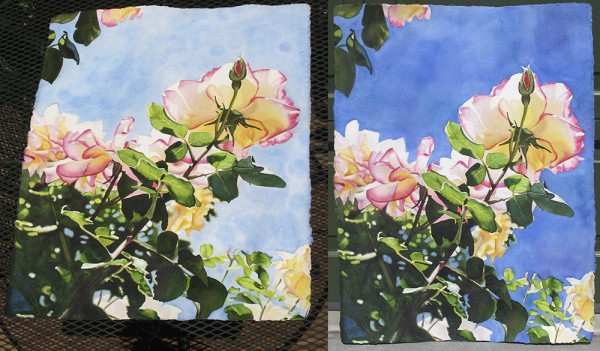
With August Bounty, I didn’t have a good drawing of the ivy – the image was dark and I couldn’t see to draw it well. I tried to make it up as I painted. What I had painted was so bad that, though I had ¾ of the ivy painted, I put the whole piece of paper in the kitchen sink and sponged it off. I dried it flat, took a new, lighter photo of the ivy, re-drew and re-painted it from the start. That’s recovery! There are some green stains that can be seen through the tan-colored paint over to the right (see the detail photo) – which I think actually makes it a bit more interesting. And – that I’ve done this has made me a better artist and a better teacher.
I joke often about offering a workshop called “Can this Painting Be Saved?” Artists would bring the work that is tucked away because they don’t like what they’ve done. We can’t be sure that every painting is one to be “saved,” but based on my experience, I’d bet many are. And our creative capacity expands by even attempting it. This is the real gold to be mined.
Whether it’s a tossed aside painting, a relationship that’s hit a bump or – for me – the eternal desire to take better care of myself, I’m banking on the creative capacities that lie in committing to recovering fully. I invite you to join me.
Love,
Cara
May 5, 2015 – Color is life
- At May 5, 2015
- By Cara
- In Life Stories

Listen to this post:
It’s no secret to any of you that I am pretty much obsessed by color. Looking back it started pretty early. Like probably most of us, growing up I had coloring books and Crayola crayons. I’m sure we had them at home, but my clearest memory of “coloring,” as we called it, was at Grandma and Grandpa’s house. My dad was an only child and was old at 28 when he married Mom. So when, in less than four years, the four of us came along, Grandma must have felt like she hit the grandchild jackpot! She adored us. And she devoted one of the six drawers of her dresser to us. This was where all the coloring books and crayons were. Often there were four full-sized Hershey bars waiting in there too!
I remember being a bit disappointed that no matter how hard I tried; crayons wouldn’t make a solid patch of color. From the start, I’ve wanted color to be saturated! When I was in elementary school, I used to love to make rainbows with both crayons and felt pens. Starting with red triangles in all four corners of the paper, next came orange, yellow, green, blue, purple and back to red. Then repeat until the lines, or arcs met to make a rectangle and fill the rectangle to the middle. Much later, I learned that this is called a God’s Eye. I loved how one color leads to the next and then back to the start in one continuous blend. Such a perfect system!
I’d guess that most of us are drawn to seeing color in the spectrum in this way. But, I just love being in art supply stores and seeing the color in all the paints, pencils, pastels. And they are almost always arranged in the spectrum – it just makes sense to do this! Here are some photos from the first time I went to the Sennelier art store in Paris. An art supply store in Paris, for me it hardly gets any better! My clothes in the closet are arranged in the spectrum. Color is the filter I see the world through.
When I’d been leading watercolor groups for about a year and a half, I received an email from a lovely woman in Montana who asked that I let her know when I have a weekend workshop, she’d like to come to California to take it. Weekend workshop? What weekend workshop? I asked my regular painters, if I were to teach something beyond what they get from me every week, they said: Color. You know a lot about color.
So I figured out how to present what I thought would be useful to convey about using color, pigments and paints – and a color workshop was born. While I was putting this workshop together, I went to see my spiritual director, Sister Mary – a treasured source of love, affirmation and wisdom in my life. I showed her the cover of an art supply catalog that had the spectrum – the rainbow – in art supplies and I asked her, why do we love the spectrum, why do we love color presented in this way? She said that the rainbow is light, which is God made visible. And the complete spectrum has a wholeness to it. Oh, so, it’s whole and it’s holy!
Since becoming a teacher of color, my natural curious nature has me learning all I can about it. Color is all about light, which is energy. I’m sure most people know that the color we see is the part of the spectrum of light that the object does not absorb – it’s the portion of the spectrum that is reflected back to our eyes. What blows my mind, is the capacity of the photoreceptors in our eyes to receive the different frequencies of light and how that registers in our brains to allow us to discern very subtle differences in color. And that this is a capacity we can grow. We can learn to see color with finer granularity.
Color is subjective too. It’s amazing to me what Joe will call “pink.” For me pink is pink. For him it can be a color I see as a beige with a slight red in it, or even what I’d call violet. He’s not a “pink” guy, so anything tending in that direction is labeled such. And color is personal. I’ve come to see that each artist has a palette. Paulette does not like green-green, so she uses a lot of turquoise-green and yellow-green in her paintings and they are beautiful. Gillian likes muted, sophisticated, hard to name colors. Heather’s paintings are the opposite. She uses clear, pure color in a refined and delicate harmony. Mine is a full-spectrum palette, especially as time goes on. I’m happiest when I can bring all six major colors of the color wheel – red (or pink), orange, yellow, green, blue, violet – in some form, into my paintings. Some colors may dominate, of course, but having them all there gives me a sense of “all is well, nothing is missing.” That said, red is not so much my color, for me pink is it!
Color is light – to see it there must be light – but not too much. There’s no color in the dark, but, in blinding light, there is no color either. The “colored” object is so awash in light that all of it is reflected back to us, which we see as white. Since light is energy, color is energy. The more color the more energy. Right now, most of my paintings (which are life in full color) are at my mom’s office as we are in between the weekends of Marin Open Studios. The walls are bare and the house feels different. It’s spare and empty, not just visually, but at deeper level too. Conversely, if you walk into the real estate office, you can feel the energy in the space from all the color that surrounds you. I hear this all the time – it’s not just me!
I know bold color is not for everyone. Not only do we each have our personal colors, the world has its color trends. The interior design palette for some years now has been quite muted; neutrals, greys and black and white have been the style. I read somewhere that colors become subdued when the economy is in a downturn. I was recently given a subscription to House Beautiful magazine. I’ve not read these magazines in years. But I’m really encouraged to see the recent issues filled with vibrant color. Hallelujah.
For me, color is a nutrient. It feeds me. And this makes sense, as it is energy, light, God even. Owning my love of color – and using it to express what is in me, has given me my life’s work. The thrill of putting color onto white paper never gets old. I’m watching the paintings in me become increasingly vibrant as time goes on. I see this as a reflection of my clearing the way, of opening more to allow the life-force to come through me. Color and light shows up in my paintings and I show up in the world. We each are a unique and precious expression of our source, of God. Color may or may not be how you are channeled into the world. If it is, I invite you to come out and play with me. And regardless, whatever is your way, bring it on!
Love,
Cara
